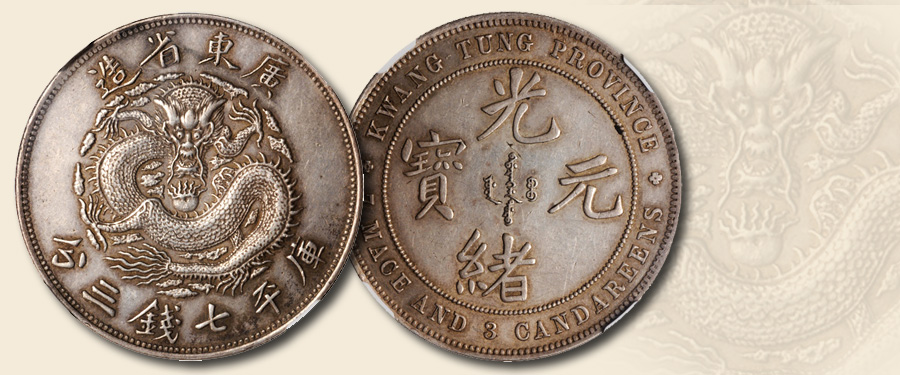
Our weekly preview item for our upcoming Stack’s Bowers and Ponterio August Hong Kong Showcase Auction is very exciting, with serious historical significance and prestige, as it stands as the First Dragon Dollar of China. Authorization to establish the Kwangtung mint was granted in 1887, implemented by Viceroy Chang Chi-Tung. In order to modernize the mint, minting machinery, dies, hubs, and other equipment were ordered from the Heaton mint at Birmingham. Upon its arrival in 1888, Kwangtung became the first mint in China to use modern minting machinery and, at this time, it was the largest mint in the world. Patterns for the first coins were designed by Allan Wyon in the denominations of 1 Dollar, 50 Cents, 20 Cents, and 10 Cents. The first Heaton patterns were later delivered to the Chinese ambassador in London. For some reason, the initial order did not include the 5 Cent piece which was struck later at the Kwangtung mint. The series is referred to by numismatists as the "Seven Three Reversed Pattern". The term "Seven Three" directly relates to the silver content. The term "Reversed Pattern" refers to the English and Chinese legends which are reversed from what later became standard. Initially, Kwangtung introduced the first coinage with a higher silver value, with the intention of replacing foreign coins circulating within China. The standard of 7 Mace 2 Candareens was raised to 7 Mace 3 Candareens in order to gain public acceptance and replace the Mexican 8 Reales. Soon after release, these pieces were being melted to retrieve the excess silver content.
The obverse contains four large Chinese characters, which depict “Kuang Hsu Yuan Pao” which means Valuable Coin (from the) Kuang Hsu (regime). In the exact center are found four Manchu characters denoting the same information. The upper legend states “Kwang-Tung Province” and the lower legend provides the weight, 7 Mace And 3 Candareens, which also provides its value of 1 Dollar when converted to the Tael system. The upper and lower legends are separated by small rosettes. The reverse of the coin features the distinctive Imperial flying Dragon in center, surrounded by Chinese characters. This upper legend reads: Made in Kwangtung Province. The lower portion states: Treasury scales, 7 Mace and 3 Candareens (denomination/weight). This coin represents the Chinese emergence into modern minting, and is therefore an important piece of Chinese numismatic history.
This coin is historically significant as it is the first of the modern machine struck silver coins of China. Represented here is the first use of what became the "standard design" for provincial mints, bearing the effigy of a facing dragon. This type became the standard design, not only for the Kwangtung mint, but for all mints in China that adopted the dragon design. The piece offered for sale here is quite RARE in that it is actually a circulation strike, most of which were melted down to retrieve the extra Candareen of silver. Pleasantly toned and showing light wear from circulation, this example offers exceptional quality for this very rare type.
Look for this and other Asian numismatic rarities in our upcoming August Hong Kong Showcase Auction and Sale. Preview this coin along with the rest of our auction this July and August at the Stack’s Bowers and Ponterio office located in Irvine, California. For details please refer to the Events Calendar link at www.StacksBowers.com. To schedule an appointment, please call 800.458.4646. While our Stack’s Bowers and Ponterio August Hong Kong Showcase Auction is closed for further consignments, we are currently taking consignments of Asian, world and ancient coins for our newly added December Macau Showcase Auction of Asian coins and currency (the inaugural show), as well as our November Baltimore and New York International auctions. Time is running short, so if you are interested in consigning your coins and paper currency (whether a whole collection or a single rarity) be sure to contact one of our consignment directors.





